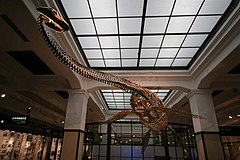Futabasaurus
Futabasaurus suzukii
Futabasaurus est un genre fossile de plésiosaures, un membre basal de la famille des Elasmosauridae. Ses restes fossiles n'ont été découverts que sur un seul site au Japon, dans la région de Fukushima. Ils proviennent de sédiments du membre Irimazawa de la formation géologique de Tamayama, dans un niveau stratigraphique daté du Crétacé supérieur (Santonien inférieur), soit il y a environ 85 Ma (millions d'années).
Une seule espèce est rattachée au genre, Futabasaurus suzukii, décrite en 2006 par Tamaki Sato (d), Yoshikazu Hasegawa (d) et Makoto Manabe (d)[1].
Description
[modifier | modifier le code]

Futabasaurus a une longueur totale estimée entre 6,4 et 9,2 mètres[2], pour une masse d'environ 3 à 4 tonnes.
Il se différencie des autres elasmosauridés par[1] :
- un plus grand écartement entre ses orbites et ses nasaux ;
- les inter-clavicules et clavicules sont fusionnées ;
- les humérus sont relativement longs ;
- les fémurs sont fins avec des insertions musculaires proéminentes.
Cladogramme
[modifier | modifier le code]Le cladogramme ci-dessous ne montre que les relations internes au sein des Elasmosauridae, sur la base des résultats d'O'Gorman et al. (2015) qui ont mené l'analyse phylogénétique la plus complète à ce jour (2022) en se concentrant sur les élasmosauridés[3].
En complément, on peut aussi consulter l'image de 2013, concernant la phylogénie complète des plésiosaures[4] :
| ◄ Elasmosauridae |
| |||||||||||||||||||||||||||||||||||||||||||||||||||||||||||||||||||||||||||||||||||||||||||||||||||||||||||||||
Les analyses précédentes de 2013[5] et 2016[6] donnaient :
| |||||||||||||||||||||||||||||||||||||||||||||||||||||||||||||||||||||||||
| Cryptoclidia |
| |||||||||||||||||||||||||||||||||||||||||||||||||||||||||||||||||||||||||||||||||||||||||||||||||||||||||
Culture populaire
[modifier | modifier le code]Futabasaurus apparaît dans la série animée Dinosaur King et plus précisément dans l'épisode « Mine de rien ».
Bibliographie
[modifier | modifier le code]![]() : document utilisé comme source pour la rédaction de cet article.
: document utilisé comme source pour la rédaction de cet article.
Publication originale
[modifier | modifier le code]- [2006] (en) Tamaki Sato, Yoshikazu Hasegawa et Makoto Manabe, « A New Elasmosaurid Plesiosaur from the Upper Cretaceous of Fukushima, Japan », Palaeontology, Londres, Wiley-Blackwell et Palaeontological Association (d), vol. 49, no 3, , p. 467-484 (ISSN 0031-0239 et 1475-4983, OCLC 44674714 et 1761779, DOI 10.1111/J.1475-4983.2006.00554.X, lire en ligne).
 .
.
Voir aussi
[modifier | modifier le code]Liens externes
[modifier | modifier le code]- Ressources relatives au vivant :
Notes et références
[modifier | modifier le code]Références taxonomiques
[modifier | modifier le code]- (en) Référence Paleobiology Database : Futabasaurus Sato et al., 2006 (consulté le )
Références
[modifier | modifier le code]- Sato, Hasegawa et Manabe 2006, p. 467-484
- (en) J.P. O'Gorman, « A Small Body Sized Non-Aristonectine Elasmosaurid (Sauropterygia, Plesiosauria) from the Late Cretaceous of Patagonia with Comments on the Relationships of the Patagonian and Antarctic Elasmosaurids », Ameghiniana, vol. 53, no 3, , p. 245–268 (DOI 10.5710/AMGH.29.11.2015.2928, lire en ligne)
- (en) José P. O’Gorman, Leonardo Salgado, Eduardo B. Olivero et Sergio A. Marenssi, « Vegasaurus molyi, gen. et sp. nov. (Plesiosauria, Elasmosauridae), from the Cape Lamb Member (lower Maastrichtian) of the Snow Hill Island Formation, Vega Island, Antarctica, and remarks on Wedellian Elasmosauridae », Journal of Vertebrate Paleontology, vol. 35, , e931285 (DOI 10.1080/02724634.2014.931285).
- (en) R. B. J. Benson, M. Evans, A. S. Smith, J. Sassoon, S. Moore-Faye, H. F. Ketchum et R. Forrest, « A Giant Pliosaurid Skull from the Late Jurassic of England », PLOS ONE, vol. 8, no 5, , e65989 (PMID 23741520, PMCID 3669260, DOI 10.1371/journal.pone.0065989
 , Bibcode 2013PLoSO...865989B).
, Bibcode 2013PLoSO...865989B).
- (en) Roger B. J. Benson, Hilary F. Ketchum, Darren William Naish et Langan E. Turner, « A new leptocleidid (Sauropterygia, Plesiosauria) from the Vectis Formation (Early Barremian–early Aptian; Early Cretaceous) of the Isle of Wight and the evolution of Leptocleididae, a controversial clade », Journal of Systematic Palaeontology, vol. 11, no 2, , p. 233–250 (DOI 10.1080/14772019.2011.634444, Bibcode 2013JSPal..11..233B, S2CID 18562271)
- (en) Rodrigo A. Otero, « Taxonomic reassessment of Hydralmosaurus as Styxosaurus: new insights on the elasmosaurid neck evolution throughout the Cretaceous », PeerJ, vol. 4, , e1777 (PMID 27019781, PMCID 4806632, DOI 10.7717/peerj.1777)

